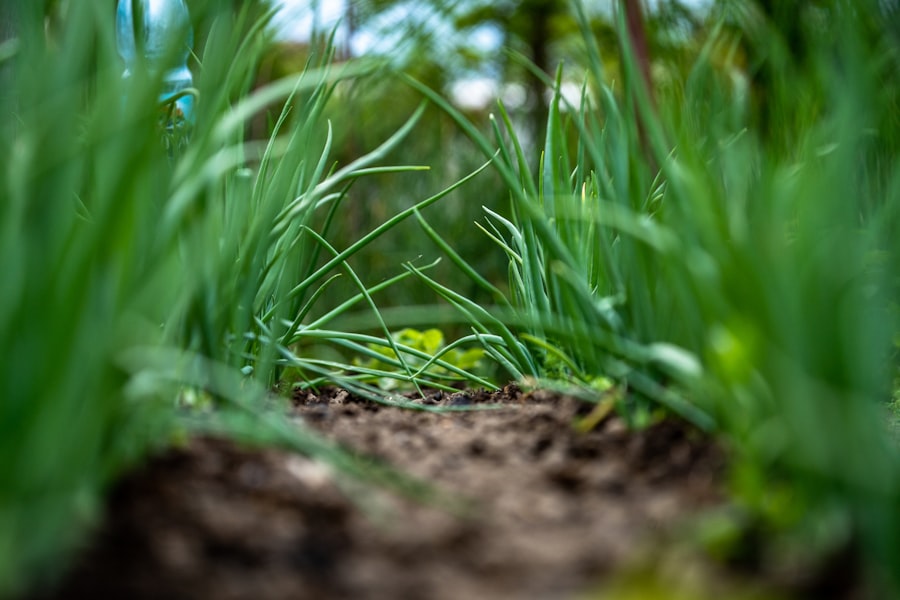Growing Green Onions: Tips and Tricks

Green onions, also known as scallions or spring onions, are a versatile and nutritious addition to any garden. These slender, green-topped onions are packed with flavor and can be used in a variety of dishes. Not only do they add a fresh and vibrant taste to salads, soups, and stir-fries, but they also provide numerous health benefits. Green onions are rich in vitamins A, C, and K, as well as folate and fiber. They also contain antioxidants that help protect against chronic diseases.
Growing your own green onions is not only a cost-effective way to enjoy this delicious vegetable, but it also allows you to have a constant supply of fresh produce right at your fingertips. By growing your own green onions, you can ensure that they are free from pesticides and other harmful chemicals. Additionally, you can harvest them at their peak freshness, which enhances their flavor and nutritional value.
Choosing the Right Soil for Green Onions
Choosing the right soil is crucial for the successful growth of green onions. They prefer loose, well-draining soil that is rich in organic matter. Sandy loam or loamy soil is ideal for green onions as it allows for proper root development and prevents waterlogging.
Before planting green onions, it is important to prepare the soil properly. Start by removing any weeds or debris from the planting area. Then, loosen the soil using a garden fork or tiller to a depth of about 6-8 inches. This will help improve drainage and allow the roots to penetrate easily.
To further enhance the soil quality, incorporate organic matter such as compost or well-rotted manure into the soil. This will provide essential nutrients and improve moisture retention. Mix the organic matter thoroughly with the soil before planting.
The Importance of Watering and Drainage for Green Onions
Proper watering is essential for the healthy growth of green onions. They require consistent moisture, but overwatering can lead to root rot and other diseases. On the other hand, underwatering can cause stunted growth and poor bulb development.
Green onions should be watered deeply once or twice a week, depending on the weather conditions. The soil should be moist but not waterlogged. To determine if the soil needs watering, stick your finger about an inch into the soil. If it feels dry at that depth, it’s time to water.
In addition to proper watering, good drainage is crucial for the health of green onions. If the soil becomes waterlogged, it can lead to root rot and other fungal diseases. To ensure proper drainage, make sure the planting area has adequate slope or use raised beds. Adding organic matter to the soil can also improve drainage by breaking up compacted soil.
Sunlight Requirements for Growing Green Onions
| Sunlight Requirements for Growing Green Onions | Optimal Amount | Minimum Amount | Maximum Amount |
|---|---|---|---|
| Hours of Sunlight per Day | 6-8 hours | 4 hours | 10 hours |
| Intensity of Sunlight | Full sun (100% intensity) | Partial sun (50% intensity) | Full shade (0% intensity) |
| UV Index | 4-6 | 2 | 8 |
Green onions thrive in full sun but can tolerate partial shade. They require at least 6-8 hours of direct sunlight each day for optimal growth. Without enough sunlight, green onions may become leggy and fail to develop strong stems and bulbs.
To provide adequate sunlight for green onions, choose a sunny spot in your garden that receives ample sunlight throughout the day. Avoid planting them in areas shaded by trees or buildings. If you have limited space or your garden is shaded, consider growing green onions in containers that can be moved to sunnier spots.
Choosing the Best Green Onion Varieties for Your Garden
There are several popular varieties of green onions to choose from, each with its own unique characteristics. Here are a few popular varieties:
1. Evergreen Bunching: This variety is known for its long, slender stalks and mild flavor. It is a perennial onion that can be harvested multiple times throughout the year.
2. White Lisbon: White Lisbon is a classic variety with white bulbs and green tops. It has a mild flavor and is quick to mature, making it a popular choice for home gardeners.
3. Red Baron: As the name suggests, Red Baron has red bulbs and green tops. It has a slightly stronger flavor compared to other varieties and adds a pop of color to dishes.
When choosing a variety, consider factors such as flavor, size, and growth habit. Some varieties may be better suited for specific climates or growing conditions. It is also a good idea to consult with local gardeners or nurseries to find out which varieties perform well in your area.
How to Plant Green Onions: Step-by-Step Guide

To plant green onions, follow these steps:
1. Preparing the soil for planting: As mentioned earlier, prepare the soil by removing weeds and debris. Loosen the soil using a garden fork or tiller and incorporate organic matter.
2. Planting green onion seeds or sets: Green onions can be grown from seeds or sets (small bulbs). If using seeds, sow them directly into the prepared soil, spacing them about 1 inch apart. If using sets, plant them about 1 inch deep and 2-3 inches apart.
3. Caring for green onion seedlings: Keep the soil consistently moist but not waterlogged. Thin out the seedlings once they reach a height of about 4-6 inches, leaving about 2 inches of space between each plant. This will allow the remaining seedlings to grow into full-sized green onions.
Fertilizing Green Onions: Dos and Don’ts
Green onions are relatively low-maintenance plants and do not require heavy fertilization. However, providing them with some nutrients can promote healthy growth and improve yields.
It is best to fertilize green onions when planting or shortly after they have germinated. Use a balanced fertilizer with equal amounts of nitrogen, phosphorus, and potassium. Apply the fertilizer according to the package instructions, taking care not to over-fertilize as this can lead to excessive leaf growth and weak bulbs.
Avoid using high-nitrogen fertilizers as they can cause the green onions to produce more leaves than bulbs. Additionally, avoid applying fertilizer too close to the plants as it can burn the roots. Water the plants after fertilizing to help distribute the nutrients evenly.
Common Pests and Diseases of Green Onions and How to Prevent Them
Like any other plant, green onions are susceptible to pests and diseases. Some common pests that can affect green onions include aphids, thrips, and onion maggots. These pests can cause damage to the leaves and bulbs, leading to stunted growth and reduced yields.
To prevent pest infestations, practice good garden hygiene by removing weeds and debris that can harbor pests. Use row covers or netting to protect young plants from insects. If necessary, use organic insecticides or insecticidal soaps to control pest populations.
As for diseases, green onions can be affected by fungal diseases such as downy mildew and white rot. To prevent these diseases, avoid overcrowding plants and provide adequate spacing for air circulation. Water at the base of the plants rather than overhead to minimize moisture on the leaves. If you notice any signs of disease, remove and destroy affected plants to prevent further spread.
Harvesting Green Onions: When and How to Do It
Green onions can be harvested at various stages of growth depending on your preference. The entire plant can be harvested when it reaches a height of about 6-8 inches for a milder flavor. Alternatively, you can harvest individual leaves as needed for a continuous supply of fresh green onions.
To harvest green onions, gently pull them out of the soil or use a garden fork to loosen the roots before lifting them out. Trim off the roots and any damaged or yellowing leaves. Rinse the green onions thoroughly before using them in your favorite recipes.
Creative Ways to Use and Store Green Onions
Green onions are incredibly versatile and can be used in a variety of dishes. They add a fresh and mild onion flavor to salads, soups, stir-fries, omelets, and more. Here are a few recipe ideas to get you started:
1. Green Onion Pancakes: Mix chopped green onions into a pancake batter and cook until golden brown. Serve with soy sauce for dipping.
2. Green Onion and Potato Soup: Sauté chopped green onions with diced potatoes in butter or olive oil. Add vegetable broth and simmer until the potatoes are tender. Blend the soup until smooth and season with salt and pepper.
3. Grilled Green Onions: Brush whole green onions with olive oil and grill until charred and tender. Serve as a side dish or chop them up and use as a topping for grilled meats or tacos.
To store green onions, wrap them in a damp paper towel and place them in a plastic bag in the refrigerator. They will stay fresh for up to a week. Alternatively, you can chop them up and freeze them in an airtight container for longer storage.
Growing green onions is a rewarding experience that allows you to enjoy fresh, flavorful produce right from your own garden. By choosing the right soil, providing adequate water and sunlight, selecting the best varieties, and following proper planting and care techniques, you can ensure a bountiful harvest of green onions. Remember to watch out for pests and diseases, harvest at the right time, and get creative with using and storing your green onions. So why not start growing your own green onions today? Your taste buds will thank you!



